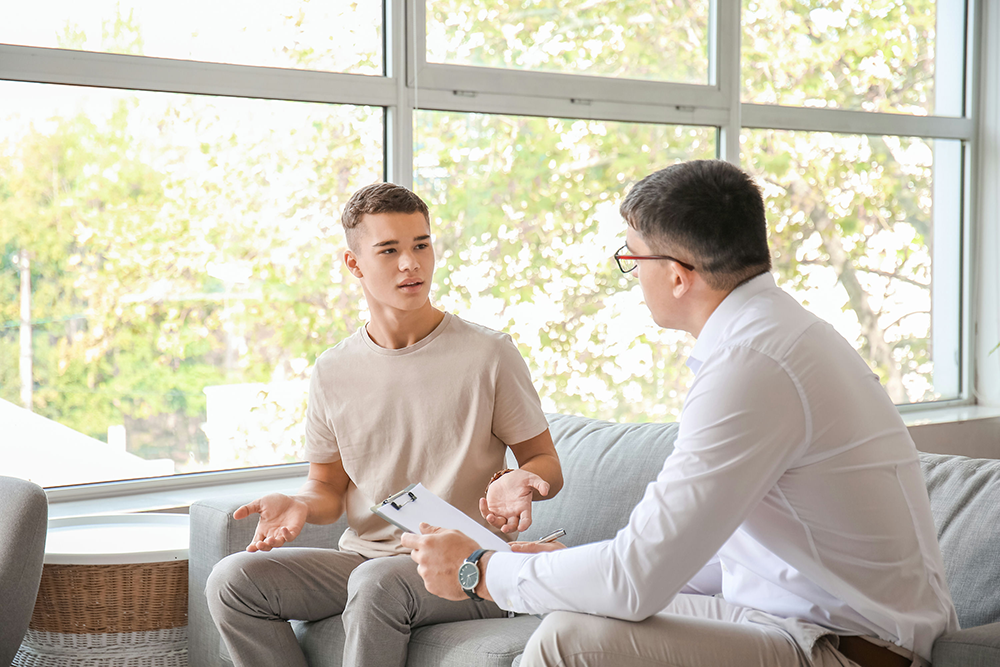As a parent, it’s confusing and frightening when a teen experiences thoughts about not wanting to live. They can often feel overwhelmed, uncertain, or even helpless when their child expresses these feelings, leaving them unsure if it stems from normal teenage behavior or mental health conditions. The good news is that you’re not alone, and there are ways to understand and address passive suicidal ideation.
Passive suicidal ideation refers to thoughts about death or wishing not to be alive, without any specific plans to act on these thoughts. While these thoughts don’t involve active planning, they still signal emotional distress that deserves attention and support. Understanding the difference between passive and active suicidal ideation is the first step in helping teens who are struggling.
At the Ohio Center for Adolescent Wellness, we specialize in supporting adolescents experiencing various levels of suicidal thoughts. We know this isn’t just about recognizing symptoms, it’s about providing the right support at the right time, which can include teen depression treatment, to help teens reclaim their emotional health and develop resilience.
What is Passive Suicidal Ideation?
Passive suicidal ideation refers to thoughts about death or wishing to be dead without any specific plans or intent to act on these thoughts. These thoughts might include “I wish I could go to sleep and not wake up,” or “Life would be easier if I weren’t here.” While these thoughts don’t involve planning or intent to die, they still indicate significant emotional distress.
According to the Centers for Disease Control and Prevention (CDC), about 18% of high school students reported seriously considering suicide in the past year, with passive thoughts being even more common. This statistic highlights how many teens silently struggle with these thoughts.
Passive suicidal ideation often comes with feelings of:
– Hopelessness: Feeling that things won’t get better
– Emotional numbness: Difficulty feeling emotions or feeling emotionally “flat”
– Overwhelming pain: Emotional distress that feels unbearable
It’s important to understand that having these thoughts doesn’t mean someone is “crazy” or “attention-seeking.” Rather, these thoughts are often the mind’s response to deep emotional pain or distress.
How is Passive Suicidal Ideation Different From Active Suicidal Ideation?
Understanding the distinction between passive and active suicidal ideation helps provide the right level of support and intervention.
Passive suicidal ideation includes:
– Thoughts about death without plans to act
– Wishing to “disappear” or “not exist”
– Feeling that life isn’t worth living
– No specific method or timeline considered
Active suicidal ideation includes:
– Specific thoughts about methods of suicide
– Making preparations or plans
– Setting a timeline
– Taking steps toward an attempt
Both forms require attention and care, but they may need different approaches. A 2022 study from the National Institute of Mental Health found that passive ideation can sometimes progress to active ideation if left unaddressed, highlighting the importance of early intervention.
Risk Factors and Warning Signs of Passive Suicidal Ideation

Recognizing risk factors and warning signs is essential for early support and intervention. While having risk factors doesn’t mean someone will definitely experience suicidal thoughts, they can increase vulnerability.
1. Mental Health Conditions
Depression, anxiety, PTSD, and other mental health disorders are strongly linked to passive suicidal ideation. According to research published in the Journal of the American Academy of Child & Adolescent Psychiatry in 2023, over 60% of adolescents with depression report some form of suicidal ideation.
Signs of depression in teens might look different than those in adults, as outlined in this guide to teen depression symptoms. Instead of sadness, teens might show:
– Irritability or anger
– Physical complaints like headaches or stomachaches
– Changes in sleep patterns
– Loss of interest in activities they once enjoyed
2. Traumatic Life Events
Significant losses or changes can trigger passive suicidal thoughts in adolescents. These might include:
– Death of a loved one
– Parental divorce or separation
– Physical or sexual abuse
– Major transitions like moving or changing schools
Research from the National Child Traumatic Stress Network shows that teens exposed to trauma are twice as likely to experience passive suicidal ideation compared to those without trauma histories.
3. Stress and Isolation
The pressure of academic performance, social media comparison, and peer relationships can create overwhelming stress for teens. This is especially true when combined with feelings of isolation or disconnection.
Recent CDC data indicates that teens who report feeling isolated from peers or family are at higher risk for both passive and active suicidal thoughts. The COVID-19 pandemic intensified these feelings for many adolescents, with isolation contributing to increased rates of suicidal ideation.
4. Identity-Related Pressures
LGBTQ+ teens and those from racial or ethnic minority groups often face unique stressors that can contribute to passive suicidal ideation. According to The Trevor Project’s 2023 National Survey on LGBTQ+ Youth Mental Health, approximately 40% of LGBTQ+ youth reported experiencing passive suicidal thoughts.
Discrimination, bullying, and lack of acceptance can create a sense of not belonging, which is a significant risk factor for suicidal thoughts.
Effective Ways to Manage Suicidal Thoughts

If you or someone you care about is experiencing passive suicidal ideation, there are effective strategies for managing these thoughts and the underlying feelings.
1. Reach Out for Professional Support
Professional mental health support is one of the most effective ways to address passive suicidal ideation. Options include:
Therapy approaches that help:
– Cognitive Behavioral Therapy (CBT): Helps identify and change unhelpful thought patterns
– Dialectical Behavior Therapy (DBT): teaches skills for managing intense emotions.
– Interpersonal Therapy: Focuses on improving relationships and communication
Treatment programs:
– Outpatient therapy: Regular sessions with a therapist
– Intensive Outpatient Programs (IOP): Several hours of therapy multiple days per week
– Partial Hospitalization Programs (PHP): Comprehensive daily treatment without overnight stays
At the Ohio Center for Adolescent Wellness, we assess each teen individually to determine which level of care best meets their needs.
2. Practice Self-Care and Stress Reduction
While self-care isn’t a substitute for professional help, it can be an important part of managing difficult thoughts and feelings:
– Physical activity: Even a 10-minute walk can release endorphins that improve mood
– Sleep hygiene: Consistent sleep and wake times help stabilize mood
– Mindfulness practices: Simple breathing exercises or guided meditations can reduce the intensity of distressing thoughts
– Creative expression: Journaling, art, or music can provide outlets for processing emotions
Research published in JAMA Pediatrics shows that teens who engage in regular physical activity report fewer depressive symptoms and suicidal thoughts.
3. Lean on Supportive Relationships
Connection with others is a powerful protective factor against suicidal ideation. Building a support network might include:
– Identifying trusted adults who can provide support
– Strengthening connections with supportive friends
– Joining groups based on shared interests
– Connecting with others who have similar experiences through support groups
When talking to others about passive suicidal ideation, it can help to use clear language: “I’ve been having thoughts about not wanting to be alive, though I don’t plan to act on them. I could use some support right now.”
4. Develop a Safety Plan
A safety plan is a personalized, practical tool that provides steps to follow when suicidal thoughts become overwhelming. Working with a mental health professional to create a safety plan might include:
– Warning signs that indicate escalating distress
– Internal coping strategies that can be used independently
– People and social settings that provide distraction
– People who can help during a crisis
– Professionals or agencies to contact
– Ways to make the environment safe
The 988 Suicide & Crisis Lifeline is a valuable resource to include in any safety plan, providing 24/7 access to trained crisis counselors.
How to Talk About Suicide with Your Adolescent
Talking about suicide does not increase risk; in fact, open conversations can be protective. Recent research from the American Foundation for Suicide Prevention supports that honest, nonjudgmental communication creates space for healing.
1. Start the Conversation Openly
Beginning a conversation about suicidal thoughts can feel intimidating, but these approaches can help:
Helpful conversation starters:
– “I’ve noticed you seem down lately. Can we talk about how you’re feeling?”
– “Sometimes people feel hopeless, have you ever felt that way?”
– “I care about you and want to understand what you’re going through.”
Choose a quiet, private time when you won’t be interrupted. Turn off phones and other distractions to show you’re fully present and that this conversation matters.
2. Show Empathy and Non-Judgment
How you respond to what your teen shares can either open or close the door to future conversations:
Do:
– Maintain eye contact and use a calm tone
– Listen more than you speak
– Validate their feelings: “It sounds like you’re really hurting right now.”
– Thank them for their honesty
Avoid:
– Minimizing their feelings: “You have nothing to be sad about.”
– Offering quick solutions: “You just need to think positively.”
– Showing shock or panic, which can make them regret opening up
Remember that your goal is to understand, not to “fix” everything in one conversation.
3. Encourage Professional Help
Suggesting professional support can be done in a way that feels supportive rather than punitive:
– Frame therapy as a sign of strength: “Talking to someone who understands these feelings can be really helpful.”
– Offer to help find a counselor or go with them to the first appointment
– Explain that many people experience these thoughts, and professional help is a normal and effective response
School counselors can often be a good first step, as they’re accessible and can provide referrals to specialized care if needed.
When to Seek Professional Intervention
While passive suicidal ideation doesn’t involve immediate plans for suicide, it still signals significant distress that deserves attention. Professional support is particularly important when:
Warning signs that require professional help include:
– Thoughts become more frequent or intense
– Passive thoughts begin to include elements of planning
– There are changes in behavior, such as giving away possessions or saying goodbyes
– The person shows increased substance use or risk-taking behaviors
– Thoughts persist for more than two weeks despite support
At the Ohio Center for Adolescent Wellness, we conduct thorough assessments to determine the appropriate level of care for each teen. Our goal is to provide enough support to ensure safety while allowing teens to maintain connections with family, school, and community when possible.
Frequently Asked Questions About Passive Suicidal Ideation
1. Will Passive Suicidal Ideation Go Away Without Treatment?
While passive suicidal ideation may temporarily decrease during periods of reduced stress, research from the National Institute of Mental Health suggests that without addressing underlying factors, these thoughts often return or intensify over time. Professional support increases the likelihood of lasting improvement by identifying and addressing root causes.
2. How Should Parents Respond When Their Teen Expresses Passive Suicidal Thoughts?
Parents can help by staying calm, listening without judgment, and validating their teen’s feelings while expressing care and concern. Avoid promises of secrecy, and instead work together to connect with professional support. Remember that your response sets the tone for future conversations about mental health.
3. Can Medication Help with Passive Suicidal Ideation?
Medication may be helpful when passive suicidal ideation is connected to conditions like depression or anxiety. According to the American Academy of Child and Adolescent Psychiatry, antidepressants can be effective as part of a comprehensive treatment plan that includes therapy and regular monitoring by a healthcare provider.
Moving Forward With Compassion And Support

Recovery is possible with the right support. Research consistently shows that a combination of professional help, supportive relationships, and self-care strategies can significantly reduce suicidal thoughts and improve quality of life. Early intervention is particularly effective, helping to address issues before they escalate.
At the Ohio Center for Adolescent Wellness, we specialize in supporting adolescents through these challenging experiences. Our team provides evidence-based therapy, comprehensive assessment, and levels of care tailored to each teen’s needs. We work closely with families to create an environment where healing can occur and resilience can grow.
If your teen is experiencing passive suicidal ideation, reaching out for help is a sign of strength, not weakness. With compassionate support and effective treatment, teens can move beyond these thoughts toward a future filled with hope and possibility.
References
- https://www.cdc.gov/healthyyouth/data/yrbs/index.htm
- https://www.nimh.nih.gov/health/topics/suicide-prevention
- https://jaacap.org
- https://www.thetrevorproject.org/survey-2023/
- https://www.nctsn.org
- https://jamanetwork.com/journals/jamapediatrics
- https://afsp.org
- https://988lifeline.org/
- https://www.aacap.org



